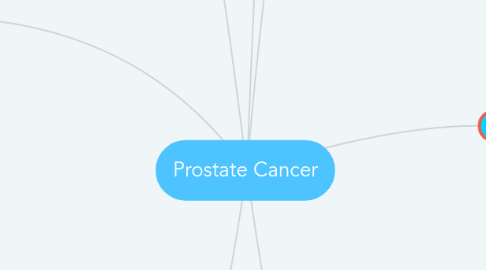
1. Epidemiology
1.1. Most common cancer in men
1.1.1. 6th leading cause of death
1.1.1.1. 2nd most frequently diagnosed cancer
1.2. Higher frequency in Western/developed countries
1.3. 91% of PC occurs in men aged 50+
1.3.1. 80% of men will develop PC by age 80
1.4. Less common in Asian and Hispanic descent by 1/3
1.4.1. Highest incidence rate in African-American men
1.5. Risk factors
1.5.1. Age, geenral health, obesity, Smoking, race/ethnicity, High fat, high red meat and dairy intake, geographical location
2. Treatment
2.1. Dependent on factors such as: 1-age 2-Gleason score 3-PSA levels 4-cancer stage 5-patient interest 5-adverse/side effects
2.2. Surgery
2.2.1. Multimodality approach
2.2.1.1. Suggested for high-risk patients
2.2.1.2. Radical prostatectomy
2.2.1.3. Lymphadenectomy
2.2.1.4. Treatment of choice if cancer is localized
2.2.2. Risks include: Death Lymph node metastesis Increased high PSA recurrence
2.2.3. Indications: Gleason score >8 Sereum PSA level <20ng/mL
2.3. Radiation
2.3.1. Second most common treatment
2.3.1.1. External beam radiotherapy
2.3.1.2. Low dose rate brachytherapy
2.3.1.3. Ideal for cancer spread to surrounding tissue
2.3.2. LDRB=increased survival rate by 91.7%
2.3.3. Sequelae: Urinary disorders Erectile disorders
2.4. Ablative therapy
2.4.1. Heat, laser, cryotherapy
2.4.2. low cost, low risk
2.4.3. High intensity or focal laser
2.4.4. Avoids radiation
2.5. Proton beam therapy
2.5.1. Localise radation dosage
2.5.1.1. ionizing radiation
2.5.1.2. Good distribution
2.5.2. increased survival rate
2.6. Hormonal therapy
2.6.1. Androgen deprivation therapy (ADT)
2.6.1.1. Inhibiting serum testosterone
2.6.1.2. Inhibiting other cell architecture, hormones and receptors
2.6.1.2.1. Androgen pathway
2.6.1.3. First line treatment
2.6.1.3.1. Does not cure PC
2.6.2. Estrogens Gonadotropin releasing hormone (GnRH) GnRH agonist GnRH antagonist Androgen receptor blocker 5-apha reductase inhibitors
2.6.3. Risks include: Erectile dysfunction Loss of libido Depression Muscle atrophy Anaemia
2.7. Chemotherapy
2.7.1. If cancer has spread outside prostate margins
2.7.1.1. Decrease pain, increase QOL
2.7.2. Chemotherapy medication of choice: Docetaxel Prednisone
2.7.2.1. Docetaxel=binding to microtubules, interfearing with cell cycles
2.7.3. Can increase survival and disease-free periods in addition to other modalities
2.8. Active surveillance
2.8.1. Useful if severity is low (BPH)
2.8.2. Asymptomatic patients
2.8.3. Can cause early death due to lack of treatment
3. Pathophysiology
3.1. Development at androgen-dependant site
3.1.1. Testosterone Dihydrotestosterone (DHT) Androgen produced in prostate and testes
3.2. Adenocarcinomas
3.3. Mutations at peripheral basal cells. Glandular cells
3.3.1. Grow via extracapsular extension
3.3.2. Remain localized within prostate
3.3.3. Cancer cells multiply and spread around surrounding tissues
3.3.3.1. Forming nodule
3.3.3.1.1. Risk of metastesis
3.4. Androgen dependant
3.4.1. Relying on androgen receptors to mediate androgen effects
3.4.2. increased expression
3.4.3. Hormone refractory prostate
4. Etiology
4.1. Most neoplasms=adenocarcinomas. Most occur in the peripheral zone of prostate and the posterior lobe.
4.2. Prostate intraepithelial neoplasia=PIN altering glandular cels
4.3. Infection, hormonal changes, dietry factors=well established risk factors
4.3.1. Inflammatory responses cause cell cycle death and injury to prostate epithelium
4.3.1.1. Causes of inflammation include: Trauma, urinary reflex and retention, hormonal imbalance
4.3.2. PC=Androgen and testosterone dependant
4.4. Male, age 50+, first degree relative with PC also risk factors
4.4.1. First degree relative=2x increased risk
4.5. P53 gene mutations, and BRCA1 & BRCA2 mutations linked with PC
4.5.1. Prostatic intraepithelial atrophy (PIA)=PC precursor
4.5.1.1. HPC1 and PCAP on chromosome 1
4.5.1.2. HOXB13 mutation=impairment of tumour suppressor function
4.5.1.2.1. Uncontrolled cellular growth and division
4.5.2. BRCA1 & BRCA2 mutations=20x more likely to get PC
4.6. Western diet and vitamin D deficiency linked to PC
4.7. Genetics responsible for 5-10% of PC
4.7.1. Hypermethylation of the GTS-P1 gene
4.7.1.1. Variations and inflammation of androgen pathways linked to development of PC
5. Diagnostics & investigations
5.1. DRE=firm, painful, nodular, wallnut
5.2. PSA >4ng/mL
5.2.1. PSA density=>0.15=malignancy
5.2.1.1. Higher density=greater risk
5.2.2. Free PSA
5.2.2.1. <25%=increased risk of PC
5.2.3. PSA doesn't ALWAYS indicate PC
5.2.3.1. PSA-low specificity
5.3. TRUS=reveal hypoechoic areas, ensity and size
5.3.1. MRI and Ultrasound are modalities of choice for early stage detection
5.4. biopsy=cancer cells
5.4.1. Histology
5.5. PET/CT=staging
5.5.1. Staging based on Gleason score
5.5.1.1. Low grade:3+3=6 High grade:4+3=7
5.6. Metastasis
5.6.1. Pelvic wall
5.6.2. Lumbar spine
5.6.3. Femoral heads
5.6.4. lymph nodes
6. Clinical features
6.1. Bladder outlet obstruction
6.1.1. Urinary retention
6.1.2. Slow stream
6.1.3. Dysuria
6.1.4. Hesitancy
6.1.4.1. Struggle to maintain stream
6.1.5. Nocturia
6.2. Haematuria
6.3. Erectile issues
6.3.1. Painful erections
6.3.2. Erectile dysfunction
6.4. Pain
6.4.1. Low back (lumbar spine)
6.4.2. Night pain
6.4.3. Pain in legs (bialteral or unilateral)
6.5. Metastasis
6.5.1. Pain at sites of metastasis
6.5.2. pathological bone fractures
6.5.3. Lymph node enlargement due to metastasis
6.6. DRE
6.6.1. Palpable mass
6.6.1.1. Nodualr, firm
